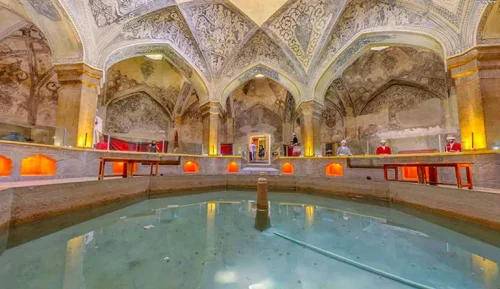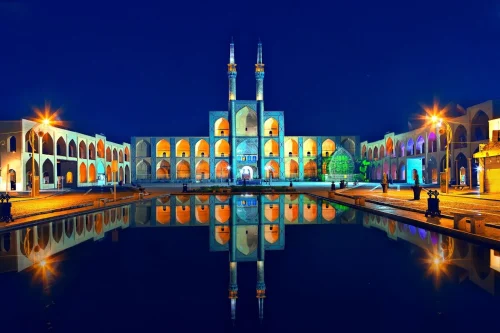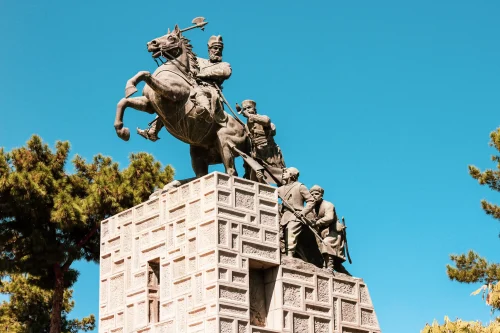Complete Guide to Alasht | Journey to the Eagle’s Nest
Alasht is one of the most beautiful tourist destinations in the Mazandaran province, known as the Eagle’s Nest due to its unique geographical location. This city attracts a large number of domestic and international tourists annually with its pleasant climate, stunning natural scenery, and numerous historical attractions. In this travelogue, we will provide a complete overview of Alasht, its local culture and customs, places to see, and the best times to visit this beautiful city.
Tourism in Alasht: The Eagle’s Nest
Complete Introduction to Alasht and Its Natural Attractions
Alasht, one of the most beautiful tourist destinations in Mazandaran province, is known as the Eagle’s Nest due to its stunning natural landscapes and unique geographical location. This region, with its towering mountains, dense forests, and flowing rivers, attracts many domestic and foreign tourists every year. A trip to Alasht offers a great opportunity to enjoy untouched nature, walk along scenic paths, and experience relaxation. The tea gardens and diverse flowers in this region add a special charm to Alasht that captivates every visitor.
History and Culture of Alasht: Journey to the Eagle’s Nest
Alasht has a rich history and diverse culture that dates back to ancient times. This city in Mazandaran province, with a history of over two thousand years, has witnessed numerous cultural and historical transformations. The people of Alasht belong to the Tabari ethnic group and speak the Savadkouhi dialect, which has unique characteristics. Local customs, traditional ceremonies, and folk celebrations are among the prominent features of Alasht’s culture that attract visitors. Additionally, local handicrafts such as jajim weaving and kilim weaving showcase the high craftsmanship of the people in this area.
The Best Time to Visit Alasht: An Unparalleled Experience
The best time to visit Alasht is during spring and summer, when the pleasant and delightful weather welcomes tourists. In spring, the colorful blooming nature of Alasht creates beautiful and pleasant scenery. Summers also offer cool and fresh air, making them a suitable time for nature tourism and visiting natural attractions. If you are looking for a relaxing experience in pleasant weather, these two seasons are the best choice for traveling to Alasht.
Climate of Alasht: Suitable Climatic Conditions for Tourists
Alasht has a mountainous climate, which means cool and moderate weather in most seasons of the year. Spring in Alasht, before the weather warms up, is cool and fresh, and summers are accompanied by pleasant temperatures, making this area a popular summer destination. Autumn also brings a special beauty to Alasht with abundant rainfalls and cool weather. Winters have lower temperatures and may experience severe cold, but this season also has a special attraction for nature and snow enthusiasts.
Villages and Scenic Areas of Alasht: Discovering Pristine Beauties
Alasht is composed of several villages and neighborhoods, each with its unique features. The villages of Suvarrudbar, Hali Chal, Galyan, and Cherat are among the scenic villages of Alasht, providing a peaceful environment for visitors with their pristine nature and beautiful landscapes. Each village has its own attractions such as fruit gardens, natural walking trails, and traditional houses, offering a different and pleasant experience for tourists.
Economy and Handicrafts of Alasht: Women’s Role in Value Creation
The economy of Alasht is based on animal husbandry and the production of various handicrafts. Local women, with their artistic hands, produce various types of jajim, kilim, and Sachin, which constitute an important part of the city’s economy. Additionally, agriculture, such as growing wheat, potatoes, and beets, is another economic foundation of Alasht. Cherry, hazelnut, and walnut trees not only add to the natural beauty of Alasht but also provide some of the city’s income through their fruits.
Historical Attractions of Alasht:
Alasht is home to several important historical attractions, which constitute the main attractions of this city. The Alasht Anthropology Museum, the Temple of the Pure Maiden, the Alasht Observatory, and the Imam Hussein Mosque are among the significant historical buildings of this region. Each of these places, with a rich history and beautiful architecture, tells stories of the past that take visitors on a journey through time and provide a rich cultural experience.
Local Foods and Restaurants of Alasht: Enjoying Authentic Flavors
Alasht, with its delicious and diverse local foods, is one of the popular culinary destinations in Mazandaran. Foods such as Keihi Polow, Sabzi Polow with walnuts, stuffed lamb, and Kons Noon are some of the local dishes of this region with a unique taste and flavor. In addition to local foods, Alasht restaurants also offer a pleasurable dining experience for tourists by providing a variety of traditional and modern dishes. Restaurants like Alasht Restaurant and Asareh Su Restaurant are some of the most famous dining places in this city where you can enjoy their authentic flavors.
Alasht Access and Accommodation Guide: Better Trip Planning
Access to Alasht is possible through personal vehicles or trains. The distance from Tehran to Alasht is about 254 kilometers, and by choosing to travel by personal car or using the Tehran-Sari train, you can easily reach this region. For accommodation in Alasht, a variety of eco-lodges and luxury villas are available to tourists. The Iran Charter website offers various accommodation options to help you choose the most suitable place for your stay and make the most of your trip to Alasht.
Things to Know When Traveling to Alasht: Full Readiness for an Unparalleled Experience
There are recommendations for traveling to Alasht that can improve your experience. These tips include booking accommodation in advance, ensuring the health of the vehicle for car trips, carrying essential medications and mineral water, and researching the area’s weather. Respect for Alasht’s historical texture and environment, and buying local souvenirs from reputable shopping centers can help preserve the city’s beauty. By following these tips, you can experience a serene and enjoyable trip to Alasht.
FAQ
- Where is Alasht?
- Alasht is one of the cities in Savadkuh, Mazandaran province, approximately 254 kilometers from Tehran.
- What is the elevation of Alasht above sea level?
- The elevation of Alasht is 1805 meters above sea level.
- How far is Alasht from Tehran?
- The distance from Tehran to Alasht is 245 kilometers, which takes about 4 hours to travel.
- What are the recommended activities in Alasht?
- Recommended activities include walking in the mountains of Alasht, viewing historical and religious sites, stargazing at the Alasht Observatory, shopping, nature tourism, and dining at restaurants.
- What is the history of Alasht?
- Alasht has a rich history, with settlements in the area dating back to the times of the Amard tribe.
- What is the culture and customs of Alasht?
- The people of Alasht belong to the Tabari ethnic group and speak the Savadkouhi dialect. A traditional custom includes collecting medicinal herbs in spring by the elderly.
- What are the villages of Alasht?
- Villages of Alasht include Suvarrudbar, Hali Chal, Galyan, Cherat, and other smaller villages.
- How is the economy of Alasht?
- The economy of Alasht is based on animal husbandry and handicraft production, with parts dedicated to agriculture such as wheat and potato cultivation.
- What is the climate of Alasht like?
- Alasht has a mountainous climate with cool and pleasant springs and summers, cool and rainy autumns, and cold winters.
- When is the best time to travel to Alasht?
- The best time to travel to Alasht is in spring and summer, but if you don’t mind the heat, September and October are also suitable.
- What are the tourist attractions in Alasht?
- Tourist attractions include the historical texture, Alasht Anthropology Museum (Reza Shah Pahlavi’s house), Temple of the Pure Maiden, Alasht Observatory, Imam Hussein Mosque, and the handicrafts house.
- What are the characteristics of the historical texture of Alasht?
- The historical texture of Alasht consists of old streets and houses with gabled roofs and cobblestone pavements, covering about 70% of the city.
- What attraction does the Alasht Anthropology Museum (Reza Shah Pahlavi’s house) offer?
- The Alasht Anthropology Museum (Reza Shah Pahlavi’s house) is one of the most important historical attractions in Alasht and dates back 200 years.
- What is the Temple of the Pure Maiden?
- The Temple of the Pure Maiden is a historical temple in Alasht where local legends say only women can visit. It is essentially the temple of the water goddess Anahita.
- What features does the Alasht Observatory have?
- The Alasht Observatory, built at an altitude of 1800 meters, is one of the tallest observatories in Iran and is highly attractive for astronomy enthusiasts.
- What features does the Imam Hussein Mosque in Alasht have?
- The Imam Hussein Mosque, with its beautiful architecture including pointed arches and a 12-sided dome, is one of the most beautiful mosques in northern Iran, built by Hossein Lorzadeh in 1973.
- How is the handicrafts house of Alasht?
- The handicrafts house in Alasht is a suitable place to observe and buy local handicrafts such as jajim weaving and other artistic products.
- What souvenirs and handicrafts does Alasht offer?
- Souvenirs from Alasht include various jajims, kilims, saachins, and local food products like dates and yogurt.
- What are the local foods of Alasht?
- Local foods of Alasht include Keihi Plow, Sabzi Polow with walnuts, stuffed lamb, and Kons Noon.
- What facilities do Alasht restaurants offer?
- Alasht restaurants, like Alasht Restaurant and Asareh Su Restaurant, offer various local and traditional dishes in pleasant environments.
- What are the shopping centers in Alasht?
- Shopping centers in Alasht include local bazaars, the handicrafts house, and the anthropology museum bazaar.
- How is accommodation in Alasht?
- For accommodation in Alasht, you can use available eco-lodges and villas, which can be booked on the Iran Charter website.
- What are the ways to access Alasht?
- Access to Alasht includes traveling by personal vehicle via the Tehran-Pardis highway and Firouzkouh road, or traveling by train and walking from the Pol Sefid station.
- What are the important tips to know when traveling to Alasht?
- Important tips include booking accommodations in advance, ensuring your vehicle’s health, carrying essential medications, wearing warm clothes in spring, caring for the historical texture, purchasing local souvenirs, having identification and cash, and checking the weather conditions.











